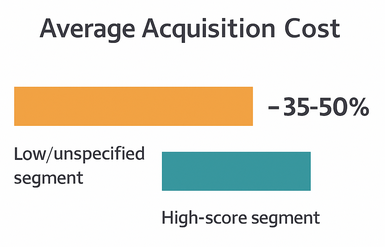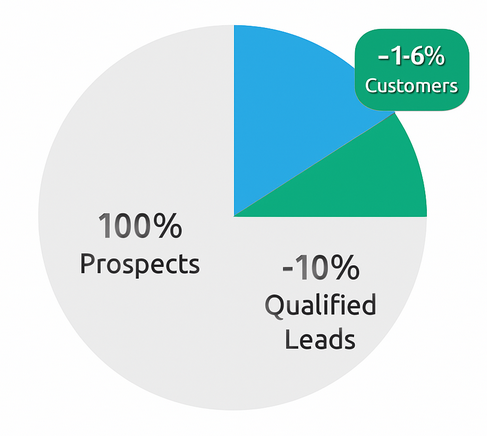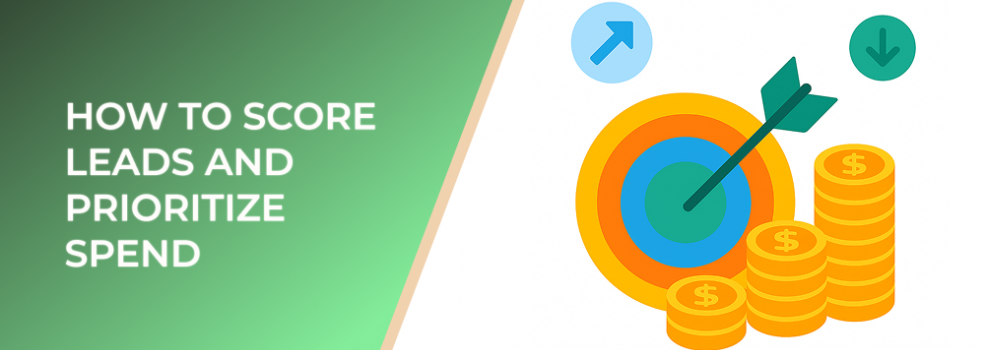Marketing budgets are increasingly scrutinized, making it essential to allocate spend toward leads with the highest revenue potential. A structured lead‑scoring system enables you to identify which prospects are most likely to convert and where you should invest more aggressively.
This article breaks down how lead scoring works, what data you need, and how to use scoring insights to guide smart spending decisions.
What Is Lead Scoring?
Lead scoring is a method of assigning value to each prospect based on their likelihood to convert. Scores are typically based on demographic data, behavioral activity, engagement signals, and expressed intent.

Only about 10% of prospects become qualified leads and just 1-6% convert into customers
According to industry surveys, companies using lead scoring experience up to a 77% increase in lead generation ROI, mainly due to better funnel prioritization and faster response times. Additionally, organizations with mature scoring models report 28% higher sales productivity, showing how much impact these systems can have.
Types of Data Used in Lead Scoring
A reliable scoring model uses four categories of data:
1. Demographic Scores
These scores evaluate whether a lead fits your ideal customer profile. Variables may include location, company size, or role.
2. Behavioral Scores
These track actions such as page views, product interactions, and engagement with ads.
3. Intent Scores
Intent signals—like repeated visits or high‑intent keywords—correlate strongly with purchase readiness. Research shows that leads with active intent signals convert 2.3x more often than general traffic.
4. Engagement Scores
Email opens, ad clicks, and similar actions help you distinguish between cold, warm, and hot leads.
Building a Lead‑Scoring Model
To construct a scoring system that aligns with your funnel, follow these steps:
1. Define Your Ideal Customer Profile
Outline the characteristics that consistently match your converted customers.
2. Identify High‑Value Actions
Assign point values to actions based on real conversion patterns. For example:
-
Product page visit: +5 points
-
Pricing page visit: +10 points
-
Requesting a demo: +25 points
3. Use Negative Scoring
Not all actions show buying intent. Lack of engagement over time, irrelevant industry fit, or unsubscribing from a list may reduce a score.
4. Set Qualification Thresholds
Typical systems classify leads into tiers such as "marketing qualified," "sales qualified," or "nurture." A structured tiering system creates predictable workflows.
How Scoring Helps Prioritize Spend
Lead scoring becomes especially powerful when used to guide budget allocation.
1. Direct More Spend Toward High‑Score Segments
Studies indicate that high‑scoring audiences can produce 35–50% lower acquisition costs because campaigns reach more likely buyers.
2. Cut Wasted Spend on Low‑Value Leads

Leads with high scores can achieve 35-50% lower acquisition costs
By excluding low‑scoring segments from retargeting or lookalike generation, marketers typically see 15–22% savings in remarketing budgets.
3. Improve Sales and Marketing Alignment
Clear score thresholds help teams focus on shared goals and reduce delays.
Optimizing Your Scoring Model
Lead scoring must evolve as your pipeline grows. You can improve your scoring accuracy by:
1. Analyzing Closed‑Won Data
Review which actions and characteristics repeatedly predict successful deals.
2. Updating Scores Quarterly
Market conditions and customer behavior change, so your model should adapt.
3. Testing Scoring Weights
A/B tests can help validate whether your top‑scoring leads convert at higher rates.
4. Connecting Scoring with Automation
Use scores for automated routing, nurture sequences, and customized retargeting.
Example Scoring Framework
Here is a simplified model that many teams use:
-
0–30 points: Nurture segment — low intent, minimal spend
-
31–60 points: Active interest — keep in remarketing pools
-
61–90 points: High‑value leads — prioritize paid spend
-
90+ points: Sales‑ready — immediate outreach, highest bidding tier
In practice, companies that implement tiered spend allocation often see 20–40% improvement in marketing efficiency within the first six months.
Suggested Reading
Here are three additional articles that complement this topic:
Conclusion
Lead scoring empowers marketers to make smarter decisions about where to invest their budgets. By using engagement, intent, demographic indicators, and historical patterns, you can identify high‑value prospects and concentrate spend where it generates the greatest ROI.
A well‑designed scoring model helps you reduce wasted spend, improve lead quality, and create a more predictable growth engine.

